Tesco: Macro Environmental Influences on Business Performance Report
VerifiedAdded on 2023/01/06
|18
|4347
|43
Report
AI Summary
This report provides a comprehensive analysis of Tesco's business environment, focusing on the macro-environmental influences impacting its operations. It begins with an introduction to the business environment and the company's background, including its founding and current market position. The report then delves into the different types of organizations, including private, public, and voluntary sectors, and their distinct purposes and legal structures. It examines Tesco's organizational structure and the interrelationships between departments, such as HR, finance, R&D, and production, highlighting how these departments coordinate to achieve common objectives. The report utilizes PESTLE and SWOT analyses to evaluate the external and internal environments, identifying both positive and negative aspects of the macro environment and the company's strengths and weaknesses. The analysis considers political, economic, social, technological, legal, and environmental factors and their impact on Tesco's performance. The report concludes with a summary of the key findings and recommendations for Tesco to navigate the complexities of its operating environment.
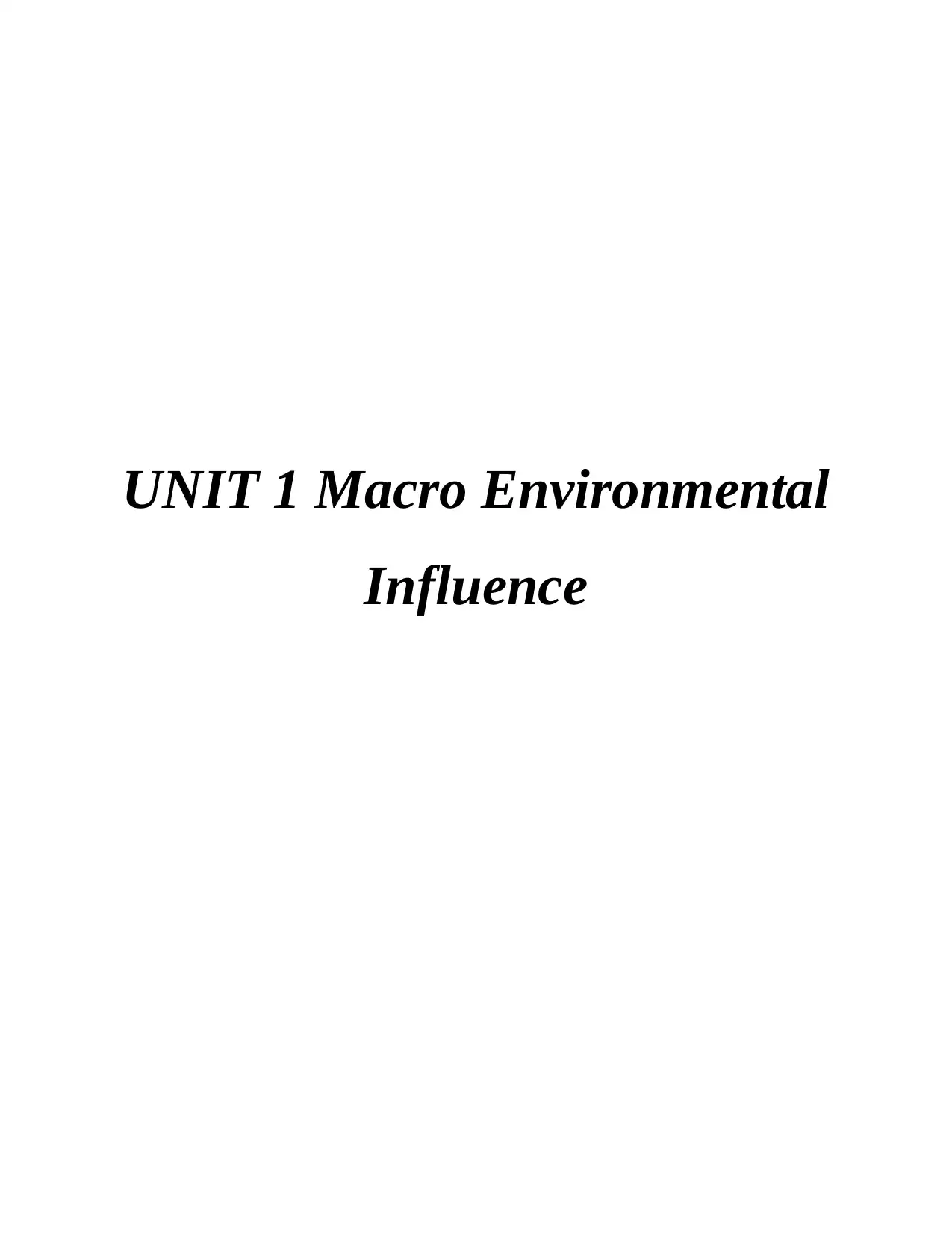
UNIT 1 Macro Environmental
Influence
Influence
Paraphrase This Document
Need a fresh take? Get an instant paraphrase of this document with our AI Paraphraser
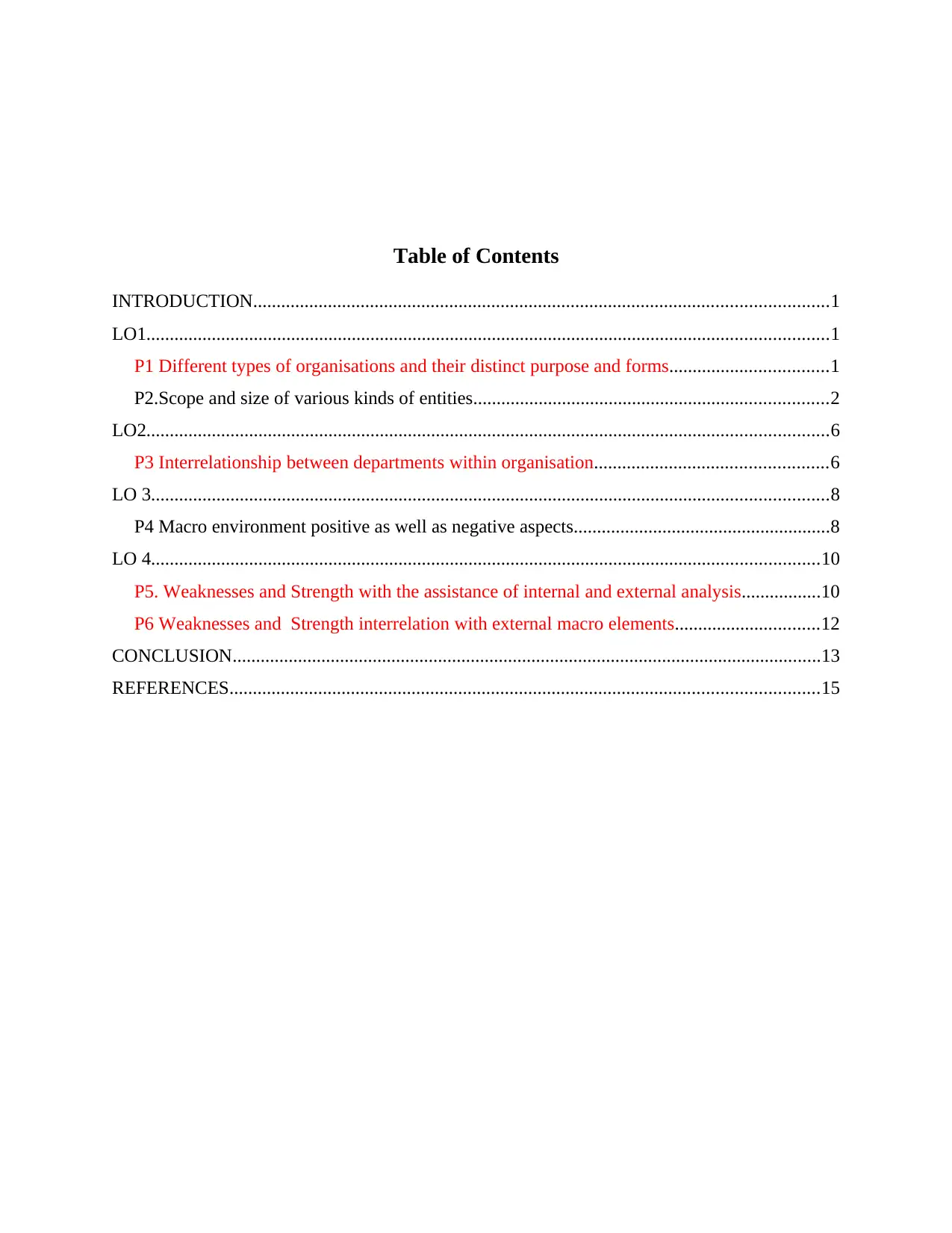
Table of Contents
INTRODUCTION...........................................................................................................................1
LO1..................................................................................................................................................1
P1 Different types of organisations and their distinct purpose and forms..................................1
P2.Scope and size of various kinds of entities............................................................................2
LO2..................................................................................................................................................6
P3 Interrelationship between departments within organisation..................................................6
LO 3.................................................................................................................................................8
P4 Macro environment positive as well as negative aspects.......................................................8
LO 4...............................................................................................................................................10
P5. Weaknesses and Strength with the assistance of internal and external analysis.................10
P6 Weaknesses and Strength interrelation with external macro elements...............................12
CONCLUSION..............................................................................................................................13
REFERENCES..............................................................................................................................15
INTRODUCTION...........................................................................................................................1
LO1..................................................................................................................................................1
P1 Different types of organisations and their distinct purpose and forms..................................1
P2.Scope and size of various kinds of entities............................................................................2
LO2..................................................................................................................................................6
P3 Interrelationship between departments within organisation..................................................6
LO 3.................................................................................................................................................8
P4 Macro environment positive as well as negative aspects.......................................................8
LO 4...............................................................................................................................................10
P5. Weaknesses and Strength with the assistance of internal and external analysis.................10
P6 Weaknesses and Strength interrelation with external macro elements...............................12
CONCLUSION..............................................................................................................................13
REFERENCES..............................................................................................................................15
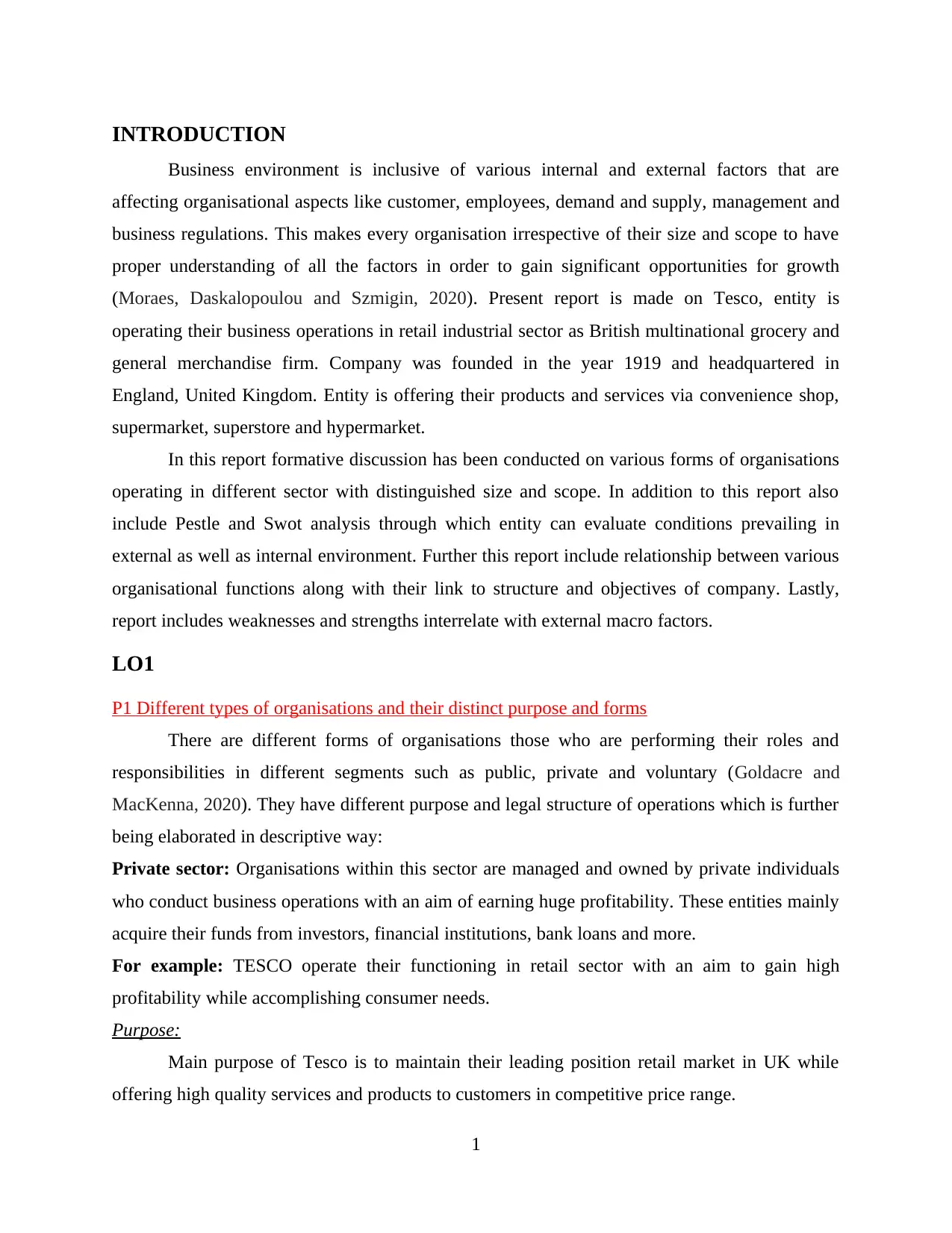
INTRODUCTION
Business environment is inclusive of various internal and external factors that are
affecting organisational aspects like customer, employees, demand and supply, management and
business regulations. This makes every organisation irrespective of their size and scope to have
proper understanding of all the factors in order to gain significant opportunities for growth
(Moraes, Daskalopoulou and Szmigin, 2020). Present report is made on Tesco, entity is
operating their business operations in retail industrial sector as British multinational grocery and
general merchandise firm. Company was founded in the year 1919 and headquartered in
England, United Kingdom. Entity is offering their products and services via convenience shop,
supermarket, superstore and hypermarket.
In this report formative discussion has been conducted on various forms of organisations
operating in different sector with distinguished size and scope. In addition to this report also
include Pestle and Swot analysis through which entity can evaluate conditions prevailing in
external as well as internal environment. Further this report include relationship between various
organisational functions along with their link to structure and objectives of company. Lastly,
report includes weaknesses and strengths interrelate with external macro factors.
LO1
P1 Different types of organisations and their distinct purpose and forms
There are different forms of organisations those who are performing their roles and
responsibilities in different segments such as public, private and voluntary (Goldacre and
MacKenna, 2020). They have different purpose and legal structure of operations which is further
being elaborated in descriptive way:
Private sector: Organisations within this sector are managed and owned by private individuals
who conduct business operations with an aim of earning huge profitability. These entities mainly
acquire their funds from investors, financial institutions, bank loans and more.
For example: TESCO operate their functioning in retail sector with an aim to gain high
profitability while accomplishing consumer needs.
Purpose:
Main purpose of Tesco is to maintain their leading position retail market in UK while
offering high quality services and products to customers in competitive price range.
1
Business environment is inclusive of various internal and external factors that are
affecting organisational aspects like customer, employees, demand and supply, management and
business regulations. This makes every organisation irrespective of their size and scope to have
proper understanding of all the factors in order to gain significant opportunities for growth
(Moraes, Daskalopoulou and Szmigin, 2020). Present report is made on Tesco, entity is
operating their business operations in retail industrial sector as British multinational grocery and
general merchandise firm. Company was founded in the year 1919 and headquartered in
England, United Kingdom. Entity is offering their products and services via convenience shop,
supermarket, superstore and hypermarket.
In this report formative discussion has been conducted on various forms of organisations
operating in different sector with distinguished size and scope. In addition to this report also
include Pestle and Swot analysis through which entity can evaluate conditions prevailing in
external as well as internal environment. Further this report include relationship between various
organisational functions along with their link to structure and objectives of company. Lastly,
report includes weaknesses and strengths interrelate with external macro factors.
LO1
P1 Different types of organisations and their distinct purpose and forms
There are different forms of organisations those who are performing their roles and
responsibilities in different segments such as public, private and voluntary (Goldacre and
MacKenna, 2020). They have different purpose and legal structure of operations which is further
being elaborated in descriptive way:
Private sector: Organisations within this sector are managed and owned by private individuals
who conduct business operations with an aim of earning huge profitability. These entities mainly
acquire their funds from investors, financial institutions, bank loans and more.
For example: TESCO operate their functioning in retail sector with an aim to gain high
profitability while accomplishing consumer needs.
Purpose:
Main purpose of Tesco is to maintain their leading position retail market in UK while
offering high quality services and products to customers in competitive price range.
1
⊘ This is a preview!⊘
Do you want full access?
Subscribe today to unlock all pages.

Trusted by 1+ million students worldwide
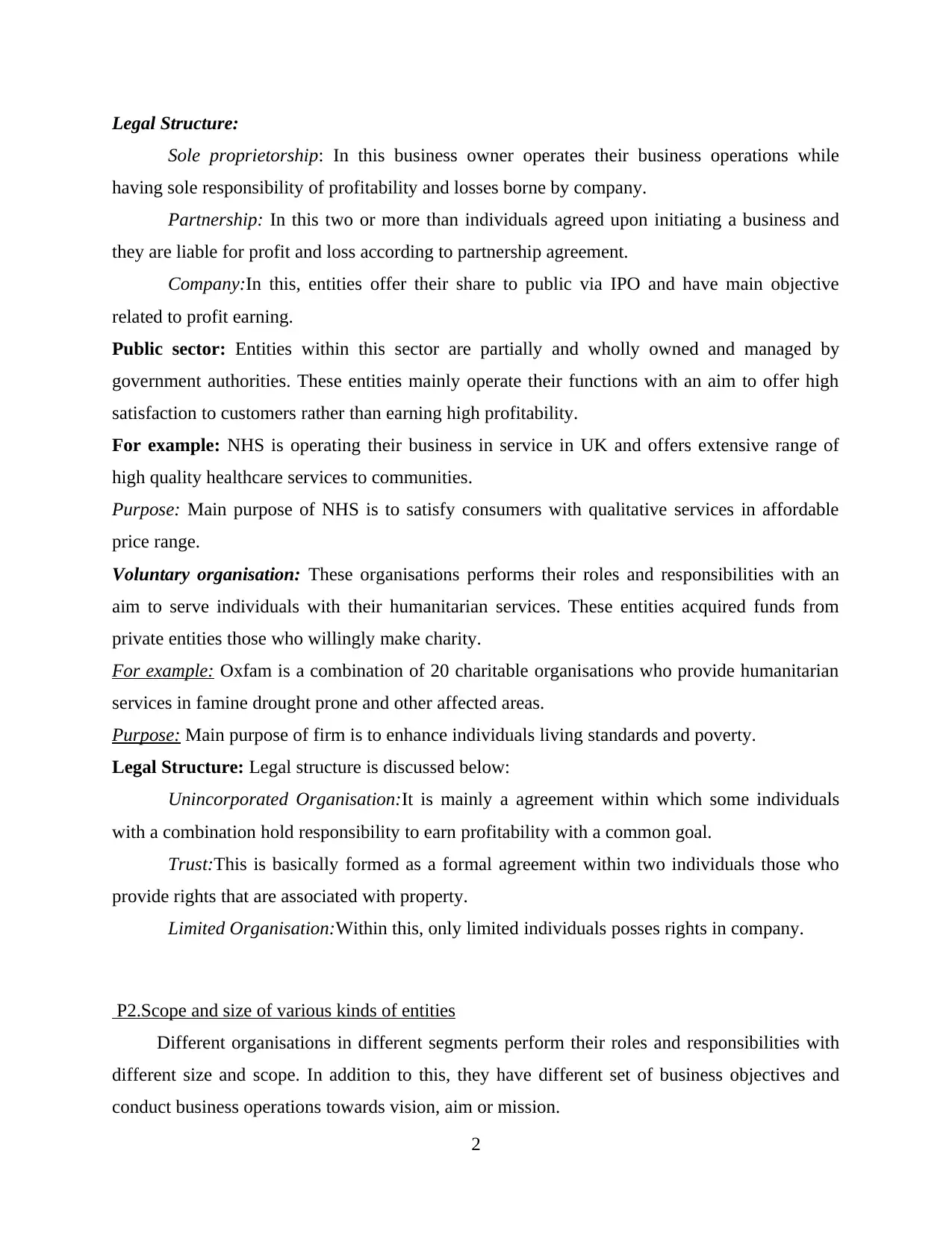
Legal Structure:
Sole proprietorship: In this business owner operates their business operations while
having sole responsibility of profitability and losses borne by company.
Partnership: In this two or more than individuals agreed upon initiating a business and
they are liable for profit and loss according to partnership agreement.
Company:In this, entities offer their share to public via IPO and have main objective
related to profit earning.
Public sector: Entities within this sector are partially and wholly owned and managed by
government authorities. These entities mainly operate their functions with an aim to offer high
satisfaction to customers rather than earning high profitability.
For example: NHS is operating their business in service in UK and offers extensive range of
high quality healthcare services to communities.
Purpose: Main purpose of NHS is to satisfy consumers with qualitative services in affordable
price range.
Voluntary organisation: These organisations performs their roles and responsibilities with an
aim to serve individuals with their humanitarian services. These entities acquired funds from
private entities those who willingly make charity.
For example: Oxfam is a combination of 20 charitable organisations who provide humanitarian
services in famine drought prone and other affected areas.
Purpose: Main purpose of firm is to enhance individuals living standards and poverty.
Legal Structure: Legal structure is discussed below:
Unincorporated Organisation:It is mainly a agreement within which some individuals
with a combination hold responsibility to earn profitability with a common goal.
Trust:This is basically formed as a formal agreement within two individuals those who
provide rights that are associated with property.
Limited Organisation:Within this, only limited individuals posses rights in company.
P2.Scope and size of various kinds of entities
Different organisations in different segments perform their roles and responsibilities with
different size and scope. In addition to this, they have different set of business objectives and
conduct business operations towards vision, aim or mission.
2
Sole proprietorship: In this business owner operates their business operations while
having sole responsibility of profitability and losses borne by company.
Partnership: In this two or more than individuals agreed upon initiating a business and
they are liable for profit and loss according to partnership agreement.
Company:In this, entities offer their share to public via IPO and have main objective
related to profit earning.
Public sector: Entities within this sector are partially and wholly owned and managed by
government authorities. These entities mainly operate their functions with an aim to offer high
satisfaction to customers rather than earning high profitability.
For example: NHS is operating their business in service in UK and offers extensive range of
high quality healthcare services to communities.
Purpose: Main purpose of NHS is to satisfy consumers with qualitative services in affordable
price range.
Voluntary organisation: These organisations performs their roles and responsibilities with an
aim to serve individuals with their humanitarian services. These entities acquired funds from
private entities those who willingly make charity.
For example: Oxfam is a combination of 20 charitable organisations who provide humanitarian
services in famine drought prone and other affected areas.
Purpose: Main purpose of firm is to enhance individuals living standards and poverty.
Legal Structure: Legal structure is discussed below:
Unincorporated Organisation:It is mainly a agreement within which some individuals
with a combination hold responsibility to earn profitability with a common goal.
Trust:This is basically formed as a formal agreement within two individuals those who
provide rights that are associated with property.
Limited Organisation:Within this, only limited individuals posses rights in company.
P2.Scope and size of various kinds of entities
Different organisations in different segments perform their roles and responsibilities with
different size and scope. In addition to this, they have different set of business objectives and
conduct business operations towards vision, aim or mission.
2
Paraphrase This Document
Need a fresh take? Get an instant paraphrase of this document with our AI Paraphraser
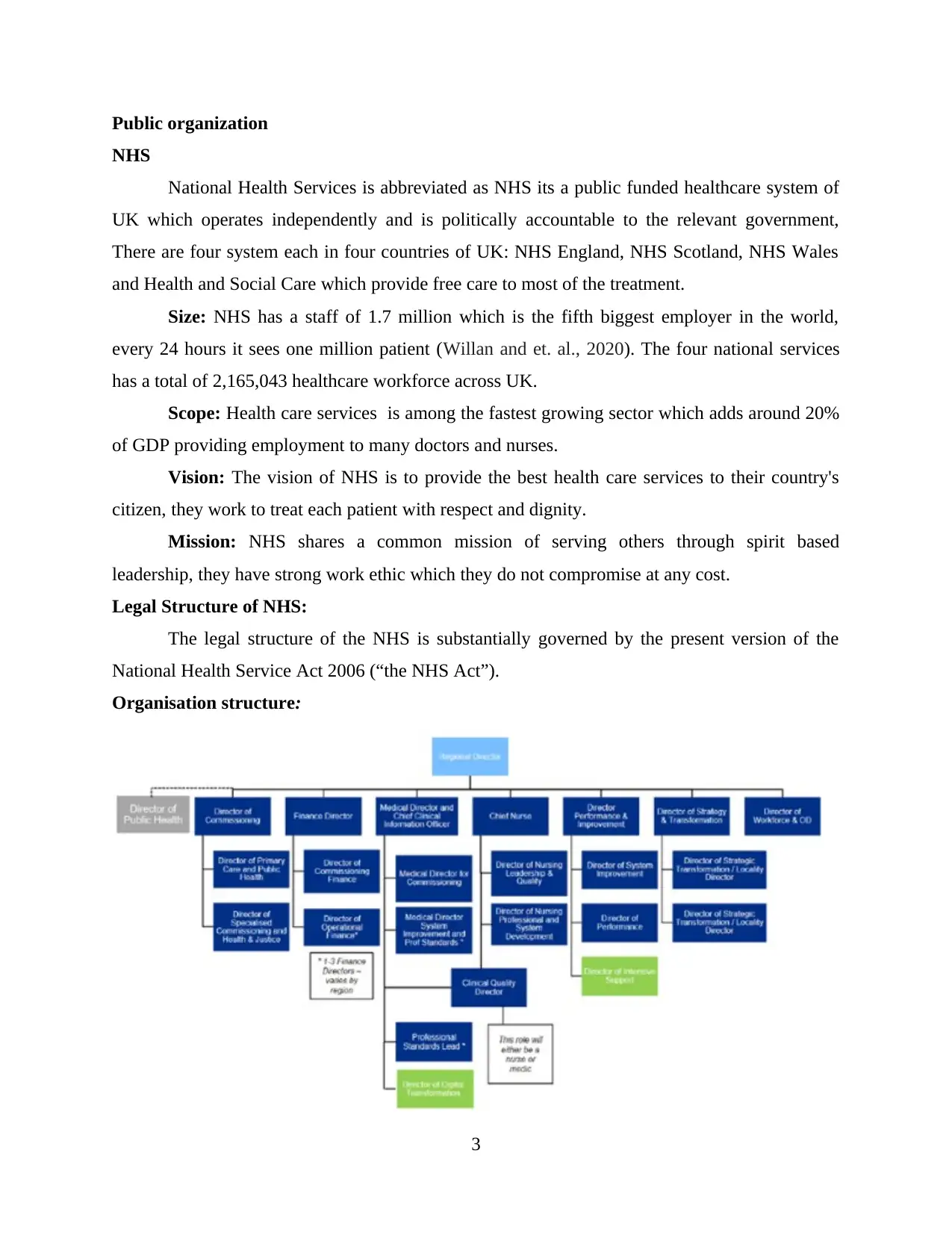
Public organization
NHS
National Health Services is abbreviated as NHS its a public funded healthcare system of
UK which operates independently and is politically accountable to the relevant government,
There are four system each in four countries of UK: NHS England, NHS Scotland, NHS Wales
and Health and Social Care which provide free care to most of the treatment.
Size: NHS has a staff of 1.7 million which is the fifth biggest employer in the world,
every 24 hours it sees one million patient (Willan and et. al., 2020). The four national services
has a total of 2,165,043 healthcare workforce across UK.
Scope: Health care services is among the fastest growing sector which adds around 20%
of GDP providing employment to many doctors and nurses.
Vision: The vision of NHS is to provide the best health care services to their country's
citizen, they work to treat each patient with respect and dignity.
Mission: NHS shares a common mission of serving others through spirit based
leadership, they have strong work ethic which they do not compromise at any cost.
Legal Structure of NHS:
The legal structure of the NHS is substantially governed by the present version of the
National Health Service Act 2006 (“the NHS Act”).
Organisation structure:
3
NHS
National Health Services is abbreviated as NHS its a public funded healthcare system of
UK which operates independently and is politically accountable to the relevant government,
There are four system each in four countries of UK: NHS England, NHS Scotland, NHS Wales
and Health and Social Care which provide free care to most of the treatment.
Size: NHS has a staff of 1.7 million which is the fifth biggest employer in the world,
every 24 hours it sees one million patient (Willan and et. al., 2020). The four national services
has a total of 2,165,043 healthcare workforce across UK.
Scope: Health care services is among the fastest growing sector which adds around 20%
of GDP providing employment to many doctors and nurses.
Vision: The vision of NHS is to provide the best health care services to their country's
citizen, they work to treat each patient with respect and dignity.
Mission: NHS shares a common mission of serving others through spirit based
leadership, they have strong work ethic which they do not compromise at any cost.
Legal Structure of NHS:
The legal structure of the NHS is substantially governed by the present version of the
National Health Service Act 2006 (“the NHS Act”).
Organisation structure:
3
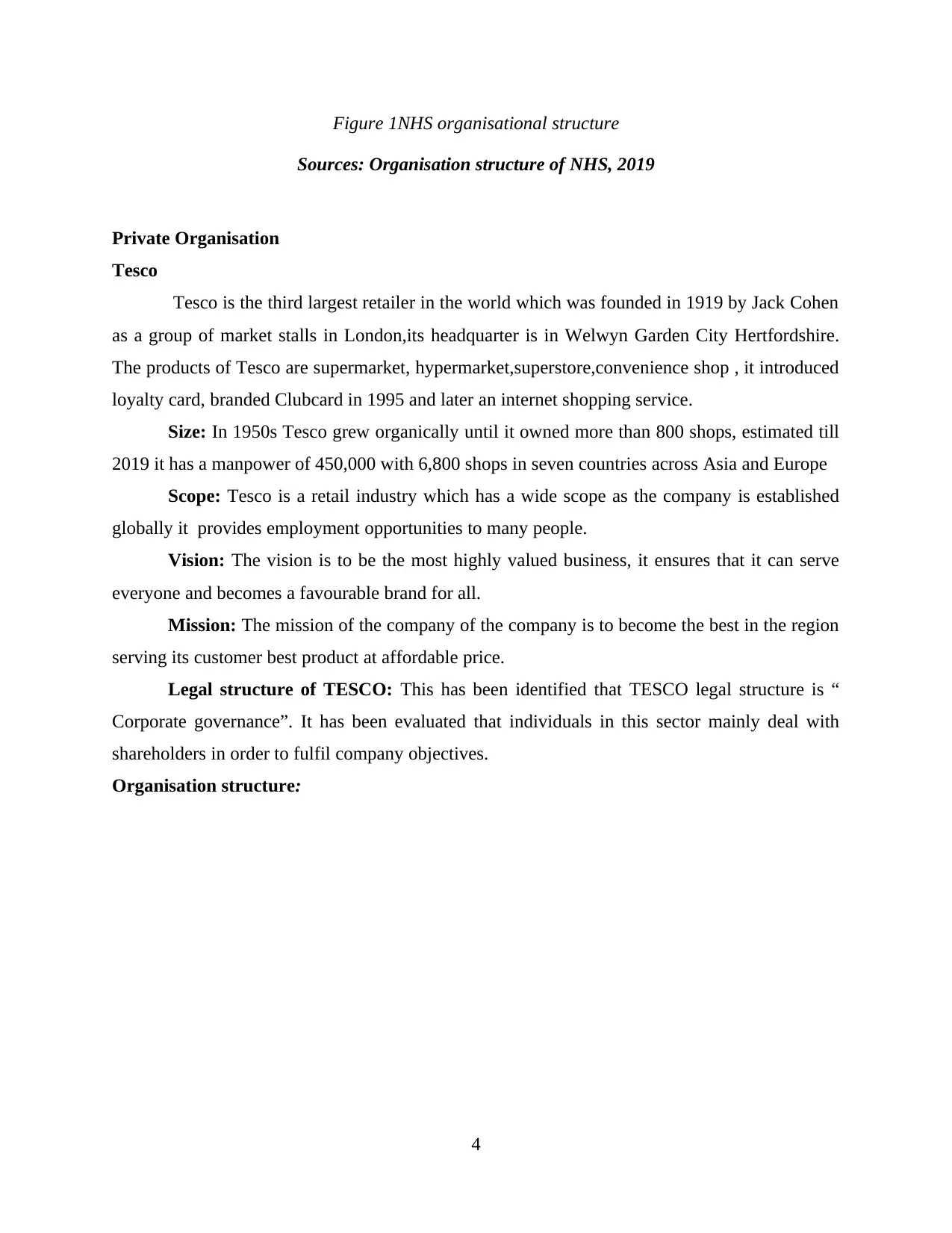
Figure 1NHS organisational structure
Sources: Organisation structure of NHS, 2019
Private Organisation
Tesco
Tesco is the third largest retailer in the world which was founded in 1919 by Jack Cohen
as a group of market stalls in London,its headquarter is in Welwyn Garden City Hertfordshire.
The products of Tesco are supermarket, hypermarket,superstore,convenience shop , it introduced
loyalty card, branded Clubcard in 1995 and later an internet shopping service.
Size: In 1950s Tesco grew organically until it owned more than 800 shops, estimated till
2019 it has a manpower of 450,000 with 6,800 shops in seven countries across Asia and Europe
Scope: Tesco is a retail industry which has a wide scope as the company is established
globally it provides employment opportunities to many people.
Vision: The vision is to be the most highly valued business, it ensures that it can serve
everyone and becomes a favourable brand for all.
Mission: The mission of the company of the company is to become the best in the region
serving its customer best product at affordable price.
Legal structure of TESCO: This has been identified that TESCO legal structure is “
Corporate governance”. It has been evaluated that individuals in this sector mainly deal with
shareholders in order to fulfil company objectives.
Organisation structure:
4
Sources: Organisation structure of NHS, 2019
Private Organisation
Tesco
Tesco is the third largest retailer in the world which was founded in 1919 by Jack Cohen
as a group of market stalls in London,its headquarter is in Welwyn Garden City Hertfordshire.
The products of Tesco are supermarket, hypermarket,superstore,convenience shop , it introduced
loyalty card, branded Clubcard in 1995 and later an internet shopping service.
Size: In 1950s Tesco grew organically until it owned more than 800 shops, estimated till
2019 it has a manpower of 450,000 with 6,800 shops in seven countries across Asia and Europe
Scope: Tesco is a retail industry which has a wide scope as the company is established
globally it provides employment opportunities to many people.
Vision: The vision is to be the most highly valued business, it ensures that it can serve
everyone and becomes a favourable brand for all.
Mission: The mission of the company of the company is to become the best in the region
serving its customer best product at affordable price.
Legal structure of TESCO: This has been identified that TESCO legal structure is “
Corporate governance”. It has been evaluated that individuals in this sector mainly deal with
shareholders in order to fulfil company objectives.
Organisation structure:
4
⊘ This is a preview!⊘
Do you want full access?
Subscribe today to unlock all pages.

Trusted by 1+ million students worldwide
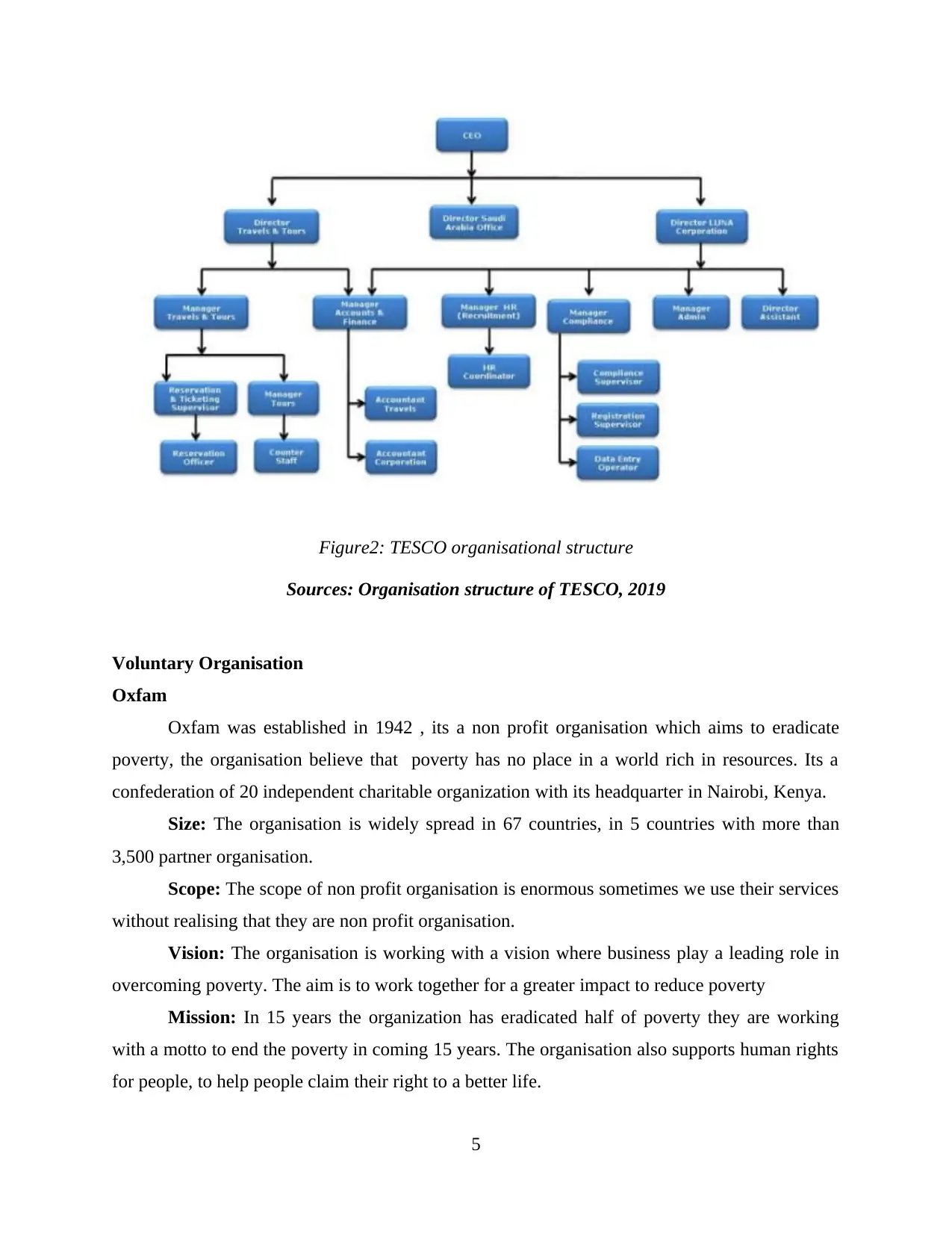
Figure2: TESCO organisational structure
Sources: Organisation structure of TESCO, 2019
Voluntary Organisation
Oxfam
Oxfam was established in 1942 , its a non profit organisation which aims to eradicate
poverty, the organisation believe that poverty has no place in a world rich in resources. Its a
confederation of 20 independent charitable organization with its headquarter in Nairobi, Kenya.
Size: The organisation is widely spread in 67 countries, in 5 countries with more than
3,500 partner organisation.
Scope: The scope of non profit organisation is enormous sometimes we use their services
without realising that they are non profit organisation.
Vision: The organisation is working with a vision where business play a leading role in
overcoming poverty. The aim is to work together for a greater impact to reduce poverty
Mission: In 15 years the organization has eradicated half of poverty they are working
with a motto to end the poverty in coming 15 years. The organisation also supports human rights
for people, to help people claim their right to a better life.
5
Sources: Organisation structure of TESCO, 2019
Voluntary Organisation
Oxfam
Oxfam was established in 1942 , its a non profit organisation which aims to eradicate
poverty, the organisation believe that poverty has no place in a world rich in resources. Its a
confederation of 20 independent charitable organization with its headquarter in Nairobi, Kenya.
Size: The organisation is widely spread in 67 countries, in 5 countries with more than
3,500 partner organisation.
Scope: The scope of non profit organisation is enormous sometimes we use their services
without realising that they are non profit organisation.
Vision: The organisation is working with a vision where business play a leading role in
overcoming poverty. The aim is to work together for a greater impact to reduce poverty
Mission: In 15 years the organization has eradicated half of poverty they are working
with a motto to end the poverty in coming 15 years. The organisation also supports human rights
for people, to help people claim their right to a better life.
5
Paraphrase This Document
Need a fresh take? Get an instant paraphrase of this document with our AI Paraphraser
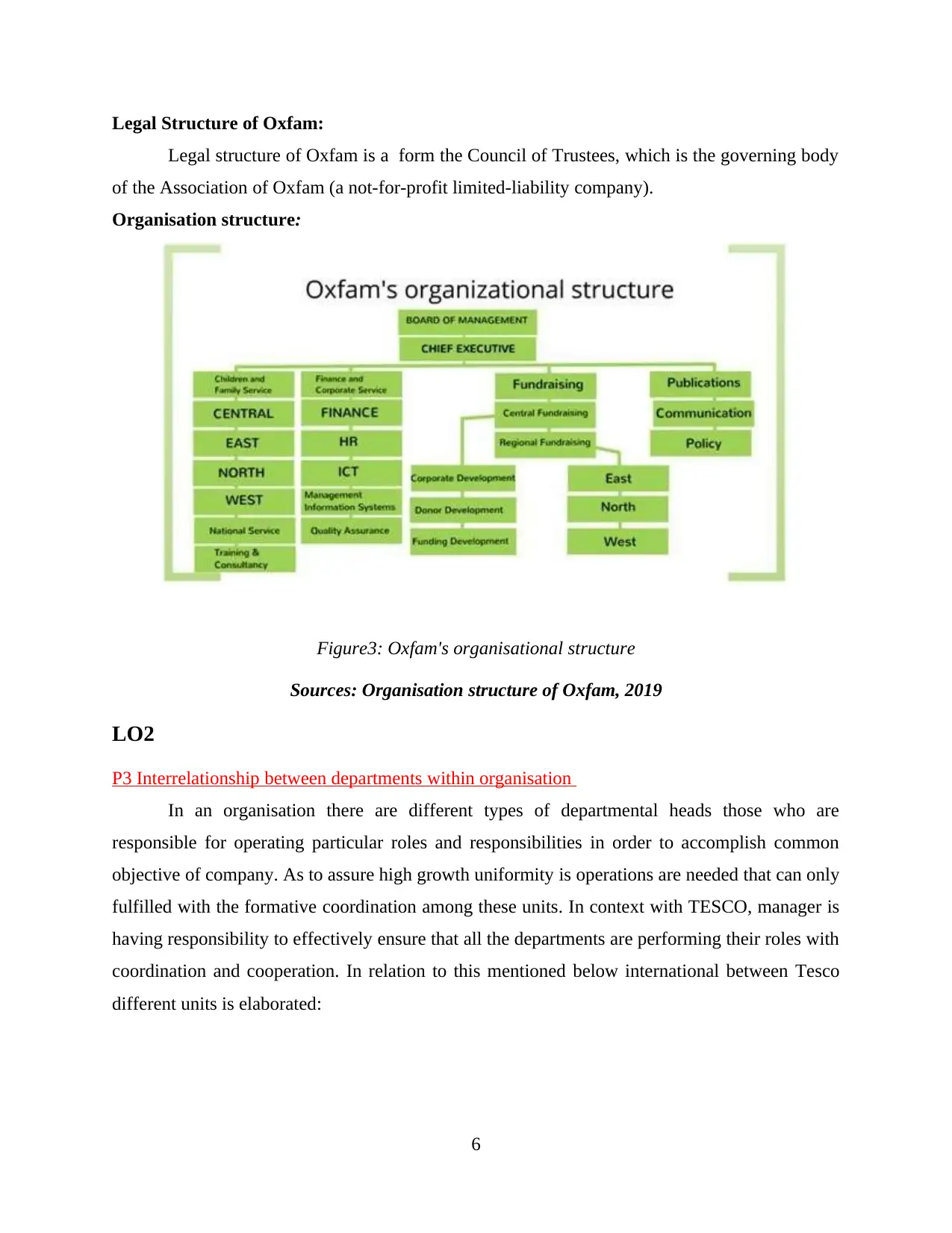
Legal Structure of Oxfam:
Legal structure of Oxfam is a form the Council of Trustees, which is the governing body
of the Association of Oxfam (a not-for-profit limited-liability company).
Organisation structure:
Figure3: Oxfam's organisational structure
Sources: Organisation structure of Oxfam, 2019
LO2
P3 Interrelationship between departments within organisation
In an organisation there are different types of departmental heads those who are
responsible for operating particular roles and responsibilities in order to accomplish common
objective of company. As to assure high growth uniformity is operations are needed that can only
fulfilled with the formative coordination among these units. In context with TESCO, manager is
having responsibility to effectively ensure that all the departments are performing their roles with
coordination and cooperation. In relation to this mentioned below international between Tesco
different units is elaborated:
6
Legal structure of Oxfam is a form the Council of Trustees, which is the governing body
of the Association of Oxfam (a not-for-profit limited-liability company).
Organisation structure:
Figure3: Oxfam's organisational structure
Sources: Organisation structure of Oxfam, 2019
LO2
P3 Interrelationship between departments within organisation
In an organisation there are different types of departmental heads those who are
responsible for operating particular roles and responsibilities in order to accomplish common
objective of company. As to assure high growth uniformity is operations are needed that can only
fulfilled with the formative coordination among these units. In context with TESCO, manager is
having responsibility to effectively ensure that all the departments are performing their roles with
coordination and cooperation. In relation to this mentioned below international between Tesco
different units is elaborated:
6
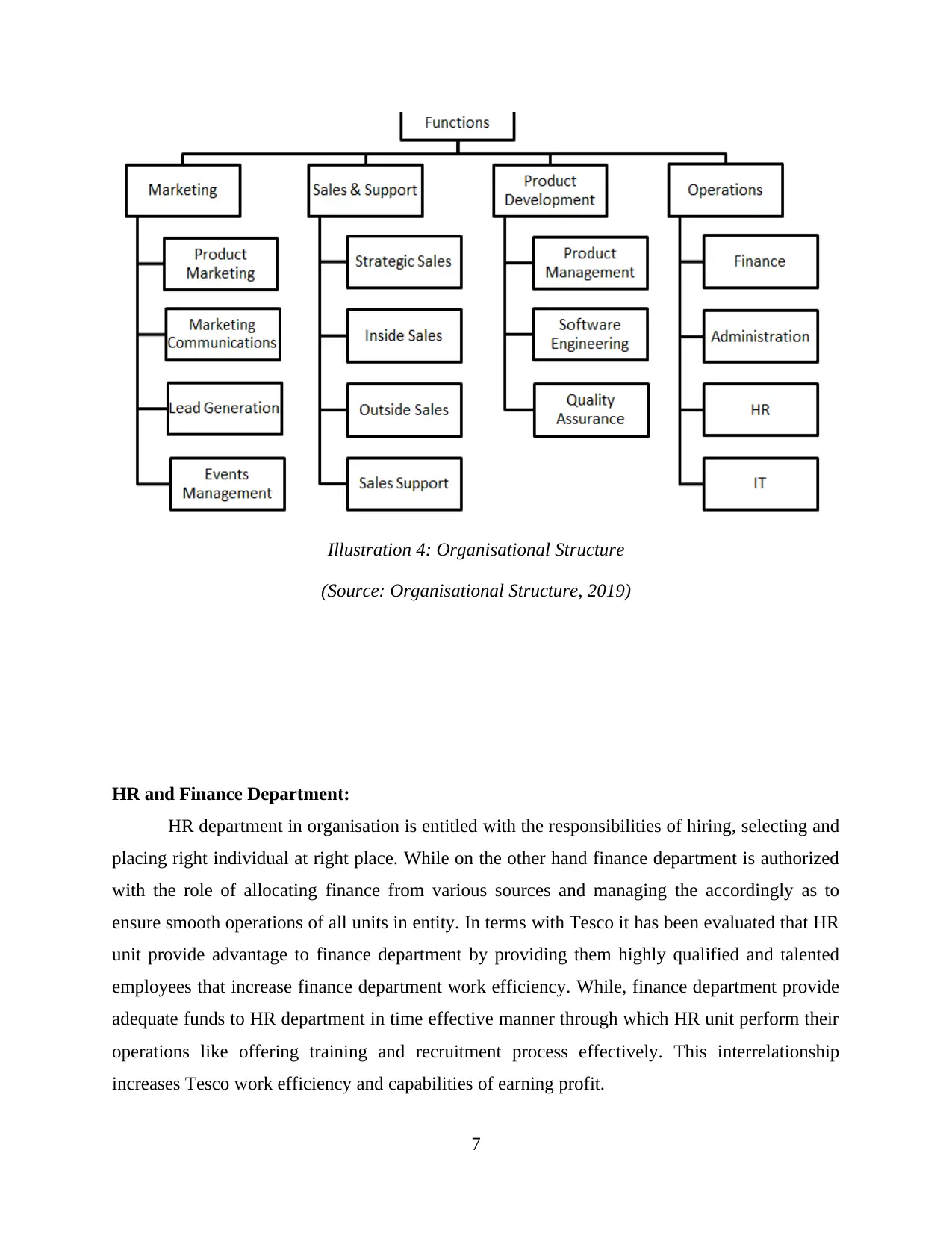
Illustration 4: Organisational Structure
(Source: Organisational Structure, 2019)
HR and Finance Department:
HR department in organisation is entitled with the responsibilities of hiring, selecting and
placing right individual at right place. While on the other hand finance department is authorized
with the role of allocating finance from various sources and managing the accordingly as to
ensure smooth operations of all units in entity. In terms with Tesco it has been evaluated that HR
unit provide advantage to finance department by providing them highly qualified and talented
employees that increase finance department work efficiency. While, finance department provide
adequate funds to HR department in time effective manner through which HR unit perform their
operations like offering training and recruitment process effectively. This interrelationship
increases Tesco work efficiency and capabilities of earning profit.
7
(Source: Organisational Structure, 2019)
HR and Finance Department:
HR department in organisation is entitled with the responsibilities of hiring, selecting and
placing right individual at right place. While on the other hand finance department is authorized
with the role of allocating finance from various sources and managing the accordingly as to
ensure smooth operations of all units in entity. In terms with Tesco it has been evaluated that HR
unit provide advantage to finance department by providing them highly qualified and talented
employees that increase finance department work efficiency. While, finance department provide
adequate funds to HR department in time effective manner through which HR unit perform their
operations like offering training and recruitment process effectively. This interrelationship
increases Tesco work efficiency and capabilities of earning profit.
7
⊘ This is a preview!⊘
Do you want full access?
Subscribe today to unlock all pages.

Trusted by 1+ million students worldwide
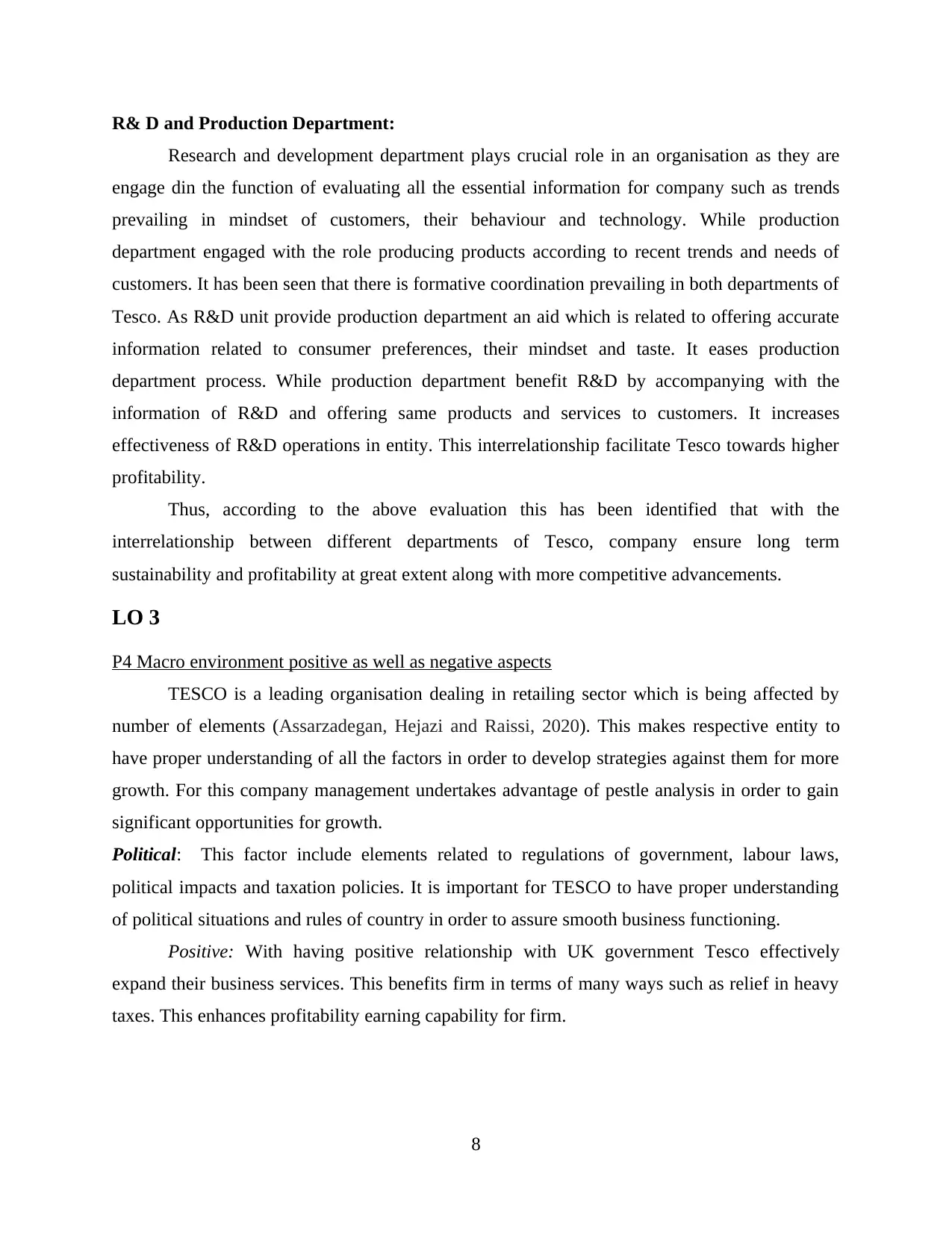
R& D and Production Department:
Research and development department plays crucial role in an organisation as they are
engage din the function of evaluating all the essential information for company such as trends
prevailing in mindset of customers, their behaviour and technology. While production
department engaged with the role producing products according to recent trends and needs of
customers. It has been seen that there is formative coordination prevailing in both departments of
Tesco. As R&D unit provide production department an aid which is related to offering accurate
information related to consumer preferences, their mindset and taste. It eases production
department process. While production department benefit R&D by accompanying with the
information of R&D and offering same products and services to customers. It increases
effectiveness of R&D operations in entity. This interrelationship facilitate Tesco towards higher
profitability.
Thus, according to the above evaluation this has been identified that with the
interrelationship between different departments of Tesco, company ensure long term
sustainability and profitability at great extent along with more competitive advancements.
LO 3
P4 Macro environment positive as well as negative aspects
TESCO is a leading organisation dealing in retailing sector which is being affected by
number of elements (Assarzadegan, Hejazi and Raissi, 2020). This makes respective entity to
have proper understanding of all the factors in order to develop strategies against them for more
growth. For this company management undertakes advantage of pestle analysis in order to gain
significant opportunities for growth.
Political: This factor include elements related to regulations of government, labour laws,
political impacts and taxation policies. It is important for TESCO to have proper understanding
of political situations and rules of country in order to assure smooth business functioning.
Positive: With having positive relationship with UK government Tesco effectively
expand their business services. This benefits firm in terms of many ways such as relief in heavy
taxes. This enhances profitability earning capability for firm.
8
Research and development department plays crucial role in an organisation as they are
engage din the function of evaluating all the essential information for company such as trends
prevailing in mindset of customers, their behaviour and technology. While production
department engaged with the role producing products according to recent trends and needs of
customers. It has been seen that there is formative coordination prevailing in both departments of
Tesco. As R&D unit provide production department an aid which is related to offering accurate
information related to consumer preferences, their mindset and taste. It eases production
department process. While production department benefit R&D by accompanying with the
information of R&D and offering same products and services to customers. It increases
effectiveness of R&D operations in entity. This interrelationship facilitate Tesco towards higher
profitability.
Thus, according to the above evaluation this has been identified that with the
interrelationship between different departments of Tesco, company ensure long term
sustainability and profitability at great extent along with more competitive advancements.
LO 3
P4 Macro environment positive as well as negative aspects
TESCO is a leading organisation dealing in retailing sector which is being affected by
number of elements (Assarzadegan, Hejazi and Raissi, 2020). This makes respective entity to
have proper understanding of all the factors in order to develop strategies against them for more
growth. For this company management undertakes advantage of pestle analysis in order to gain
significant opportunities for growth.
Political: This factor include elements related to regulations of government, labour laws,
political impacts and taxation policies. It is important for TESCO to have proper understanding
of political situations and rules of country in order to assure smooth business functioning.
Positive: With having positive relationship with UK government Tesco effectively
expand their business services. This benefits firm in terms of many ways such as relief in heavy
taxes. This enhances profitability earning capability for firm.
8
Paraphrase This Document
Need a fresh take? Get an instant paraphrase of this document with our AI Paraphraser
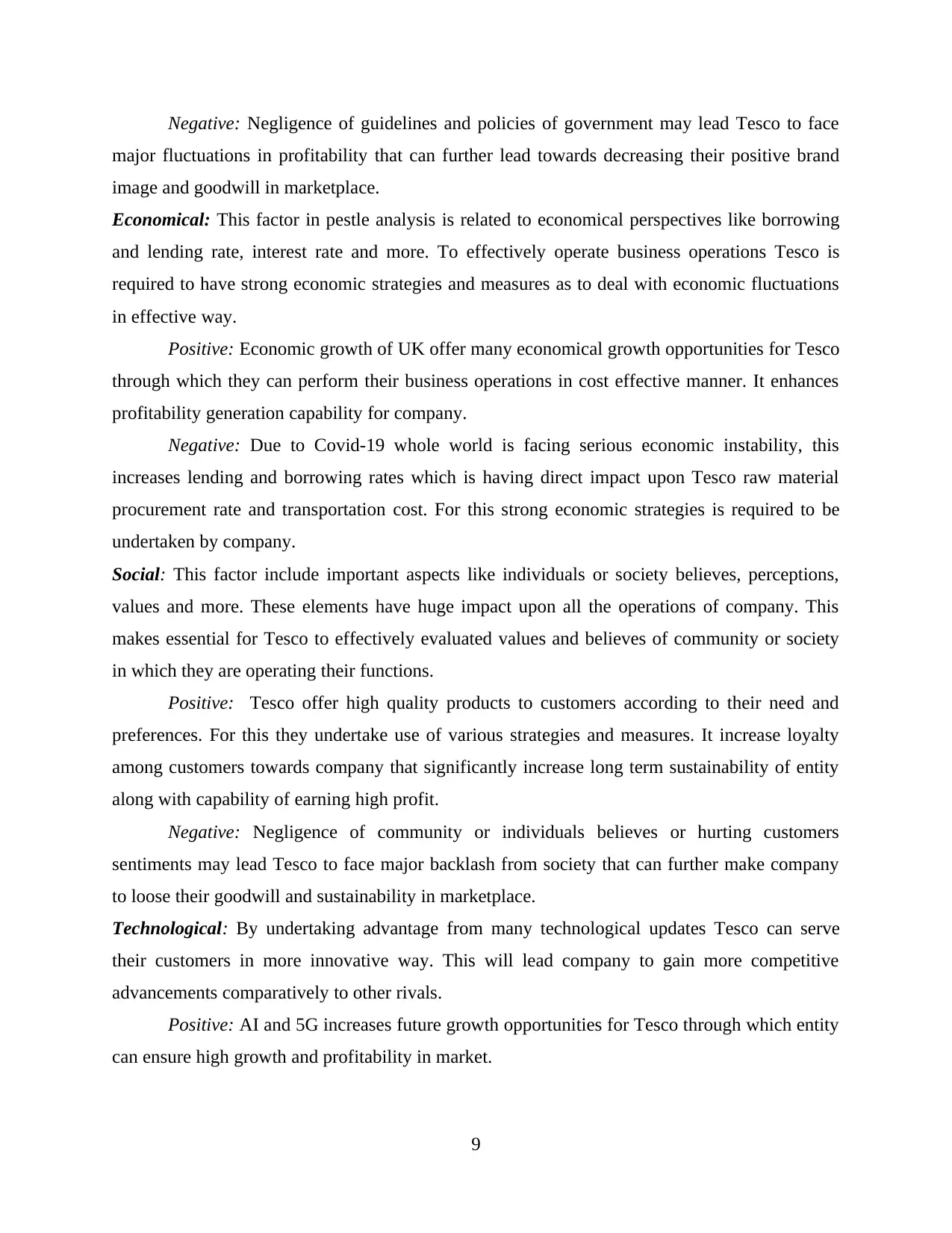
Negative: Negligence of guidelines and policies of government may lead Tesco to face
major fluctuations in profitability that can further lead towards decreasing their positive brand
image and goodwill in marketplace.
Economical: This factor in pestle analysis is related to economical perspectives like borrowing
and lending rate, interest rate and more. To effectively operate business operations Tesco is
required to have strong economic strategies and measures as to deal with economic fluctuations
in effective way.
Positive: Economic growth of UK offer many economical growth opportunities for Tesco
through which they can perform their business operations in cost effective manner. It enhances
profitability generation capability for company.
Negative: Due to Covid-19 whole world is facing serious economic instability, this
increases lending and borrowing rates which is having direct impact upon Tesco raw material
procurement rate and transportation cost. For this strong economic strategies is required to be
undertaken by company.
Social: This factor include important aspects like individuals or society believes, perceptions,
values and more. These elements have huge impact upon all the operations of company. This
makes essential for Tesco to effectively evaluated values and believes of community or society
in which they are operating their functions.
Positive: Tesco offer high quality products to customers according to their need and
preferences. For this they undertake use of various strategies and measures. It increase loyalty
among customers towards company that significantly increase long term sustainability of entity
along with capability of earning high profit.
Negative: Negligence of community or individuals believes or hurting customers
sentiments may lead Tesco to face major backlash from society that can further make company
to loose their goodwill and sustainability in marketplace.
Technological: By undertaking advantage from many technological updates Tesco can serve
their customers in more innovative way. This will lead company to gain more competitive
advancements comparatively to other rivals.
Positive: AI and 5G increases future growth opportunities for Tesco through which entity
can ensure high growth and profitability in market.
9
major fluctuations in profitability that can further lead towards decreasing their positive brand
image and goodwill in marketplace.
Economical: This factor in pestle analysis is related to economical perspectives like borrowing
and lending rate, interest rate and more. To effectively operate business operations Tesco is
required to have strong economic strategies and measures as to deal with economic fluctuations
in effective way.
Positive: Economic growth of UK offer many economical growth opportunities for Tesco
through which they can perform their business operations in cost effective manner. It enhances
profitability generation capability for company.
Negative: Due to Covid-19 whole world is facing serious economic instability, this
increases lending and borrowing rates which is having direct impact upon Tesco raw material
procurement rate and transportation cost. For this strong economic strategies is required to be
undertaken by company.
Social: This factor include important aspects like individuals or society believes, perceptions,
values and more. These elements have huge impact upon all the operations of company. This
makes essential for Tesco to effectively evaluated values and believes of community or society
in which they are operating their functions.
Positive: Tesco offer high quality products to customers according to their need and
preferences. For this they undertake use of various strategies and measures. It increase loyalty
among customers towards company that significantly increase long term sustainability of entity
along with capability of earning high profit.
Negative: Negligence of community or individuals believes or hurting customers
sentiments may lead Tesco to face major backlash from society that can further make company
to loose their goodwill and sustainability in marketplace.
Technological: By undertaking advantage from many technological updates Tesco can serve
their customers in more innovative way. This will lead company to gain more competitive
advancements comparatively to other rivals.
Positive: AI and 5G increases future growth opportunities for Tesco through which entity
can ensure high growth and profitability in market.
9
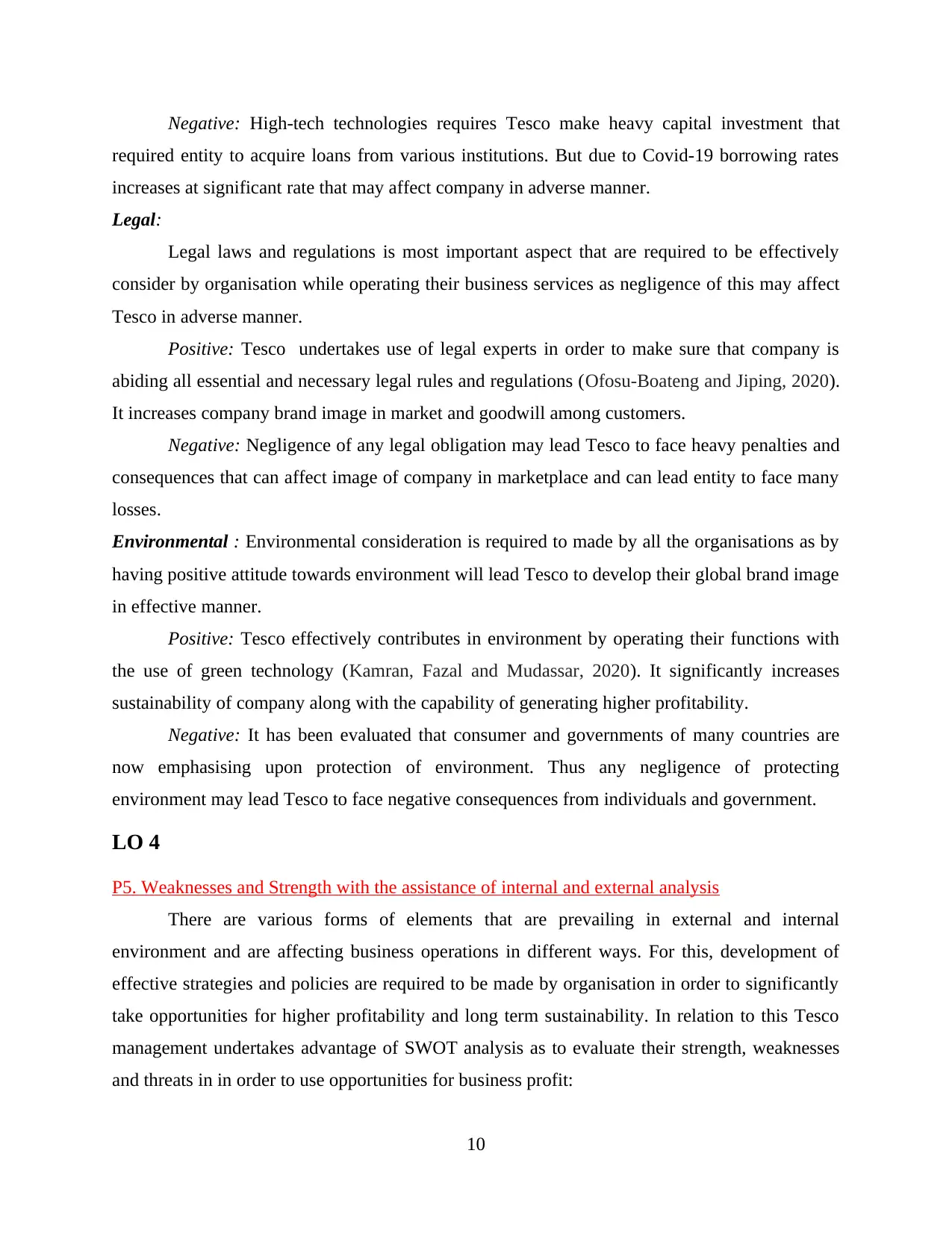
Negative: High-tech technologies requires Tesco make heavy capital investment that
required entity to acquire loans from various institutions. But due to Covid-19 borrowing rates
increases at significant rate that may affect company in adverse manner.
Legal:
Legal laws and regulations is most important aspect that are required to be effectively
consider by organisation while operating their business services as negligence of this may affect
Tesco in adverse manner.
Positive: Tesco undertakes use of legal experts in order to make sure that company is
abiding all essential and necessary legal rules and regulations (Ofosu-Boateng and Jiping, 2020).
It increases company brand image in market and goodwill among customers.
Negative: Negligence of any legal obligation may lead Tesco to face heavy penalties and
consequences that can affect image of company in marketplace and can lead entity to face many
losses.
Environmental : Environmental consideration is required to made by all the organisations as by
having positive attitude towards environment will lead Tesco to develop their global brand image
in effective manner.
Positive: Tesco effectively contributes in environment by operating their functions with
the use of green technology (Kamran, Fazal and Mudassar, 2020). It significantly increases
sustainability of company along with the capability of generating higher profitability.
Negative: It has been evaluated that consumer and governments of many countries are
now emphasising upon protection of environment. Thus any negligence of protecting
environment may lead Tesco to face negative consequences from individuals and government.
LO 4
P5. Weaknesses and Strength with the assistance of internal and external analysis
There are various forms of elements that are prevailing in external and internal
environment and are affecting business operations in different ways. For this, development of
effective strategies and policies are required to be made by organisation in order to significantly
take opportunities for higher profitability and long term sustainability. In relation to this Tesco
management undertakes advantage of SWOT analysis as to evaluate their strength, weaknesses
and threats in in order to use opportunities for business profit:
10
required entity to acquire loans from various institutions. But due to Covid-19 borrowing rates
increases at significant rate that may affect company in adverse manner.
Legal:
Legal laws and regulations is most important aspect that are required to be effectively
consider by organisation while operating their business services as negligence of this may affect
Tesco in adverse manner.
Positive: Tesco undertakes use of legal experts in order to make sure that company is
abiding all essential and necessary legal rules and regulations (Ofosu-Boateng and Jiping, 2020).
It increases company brand image in market and goodwill among customers.
Negative: Negligence of any legal obligation may lead Tesco to face heavy penalties and
consequences that can affect image of company in marketplace and can lead entity to face many
losses.
Environmental : Environmental consideration is required to made by all the organisations as by
having positive attitude towards environment will lead Tesco to develop their global brand image
in effective manner.
Positive: Tesco effectively contributes in environment by operating their functions with
the use of green technology (Kamran, Fazal and Mudassar, 2020). It significantly increases
sustainability of company along with the capability of generating higher profitability.
Negative: It has been evaluated that consumer and governments of many countries are
now emphasising upon protection of environment. Thus any negligence of protecting
environment may lead Tesco to face negative consequences from individuals and government.
LO 4
P5. Weaknesses and Strength with the assistance of internal and external analysis
There are various forms of elements that are prevailing in external and internal
environment and are affecting business operations in different ways. For this, development of
effective strategies and policies are required to be made by organisation in order to significantly
take opportunities for higher profitability and long term sustainability. In relation to this Tesco
management undertakes advantage of SWOT analysis as to evaluate their strength, weaknesses
and threats in in order to use opportunities for business profit:
10
⊘ This is a preview!⊘
Do you want full access?
Subscribe today to unlock all pages.

Trusted by 1+ million students worldwide
1 out of 18
Related Documents
Your All-in-One AI-Powered Toolkit for Academic Success.
+13062052269
info@desklib.com
Available 24*7 on WhatsApp / Email
![[object Object]](/_next/static/media/star-bottom.7253800d.svg)
Unlock your academic potential
Copyright © 2020–2025 A2Z Services. All Rights Reserved. Developed and managed by ZUCOL.





